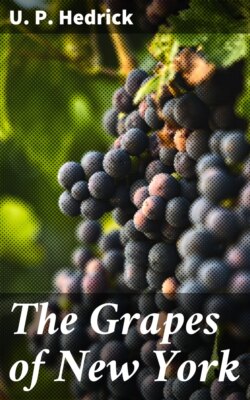Читать книгу The Grapes of New York - U. P. Hedrick - Страница 14
THE NIAGARA DISTRICT.
ОглавлениеThe Niagara district, the smallest of the several grape areas of the State, lies along the Niagara river and the southern shore of Lake Ontario. In it are about 4700 acres distributed in counties as follows: Erie, 2100; Niagara, 1250; Orleans, 375; Monroe, 700; Wayne, 380. In the southern part of Erie County the vineyards are grown under conditions very similar to those we have described in the Chautauqua district; the treatment given is much the same; the grapes are marketed as are those in the district to the south and west; and the Concord, as in the larger district, is the variety most largely grown. But conditions in the northern and eastern part of the county more nearly approach those along Niagara river and the Ontario shore so that the county is included in the Niagara district.
In Niagara, Orleans, Monroe, and Wayne Counties the grape lands are in what is known as the Ontario plain. This plain has for its western boundary in the United States, Niagara River; for its northern boundary Lake Ontario; to the south there is a high escarpment, the Niagara escarpment, or “the mountain”, separating the Ontario plain from the Erie plain which is an eastward extension of the low plain on the south shore of Lake Erie. The Niagara escarpment may be seen well at Lewiston from which point it stretches eastward toward Lockport and westward into Ontario. The escarpment may be traced to the eastern end of Lake Ontario where it disappears and the Erie and Ontario plains merge into one. In the grape-growing counties the Ontario plain varies from four to nine miles in width.
The plain is more or less rolling throughout its entire length; but in few places are the hills too steep for fruit-growing. The soils are sandy, gravelly, or clay loams varying greatly in fertility and in adaptability for the grape. In parts of the district the soils are stony and shaly. They belong, so far as they have been studied, to the Dunkirk series and are therefore quite similar to those of the Chautauqua district.
The climate, too, is much like that of the Chautauqua district. The average midwinter temperature is comparatively high; the summer temperature is equable; and the precipitation of rain and dew light as compared with inland areas. The influence of the escarpment is not so marked in the Niagara district as in the Chautauqua belt. A remarkable feature of the climate of this district is that killing frosts rarely occur before the close of October, giving a long maturing and harvesting season for the grape. In the winter the daily range of temperature is small owing not only to the influence of the water but to the fact as well that this season is a period of great cloudiness for the region.
In Erie County much of the product of the southern part is marketed with that of Chautauqua County but to the north, Buffalo makes a splendid local market. Several varieties are grown for the home market but chiefly the Concord and the Niagara. These are packed in the various styles of climax baskets and in slatted crates—the latter for the home making of wine. The fruit is carted to the market by the grower, or purchased in the field, in the case of wine-making, by the consumer.
Niagara County is the home of the Niagara grape and this variety is grown here almost exclusively. The product is sold very largely by the grower in the open markets of Buffalo and Niagara Falls and is packed in the several sizes of climax baskets. In the counties to the east of Niagara the product, almost exclusively Niagaras, is sold at Rochester or neighboring towns or shipped to the large eastern cities. Much of this fruit is sold through the Niagara Grape Market Company, a co-operative union, with headquarters at Lockport, New York.
The Niagara region is the newest of the grape districts of the State. There were few plantings along the shore of Ontario until 1886 when the Niagara grape was introduced and vineyards were put out in considerable numbers throughout the whole extent of the district followed by still heavier plantings during the succeeding several years. It was soon demonstrated that the region was well adapted to grape-growing and especially for the Niagara grape but that there were many soils and locations wholly unsuitable for vineyards. Consequently during the years that followed the bearing of the first grapes, many vineyards have been abandoned so that there are now scarcely as many acres as at the close of the first period of expansion about 1900. The insect and fungus pests are much the same as in the Chautauqua district though the dreaded grape-vine fidia is not yet nearly so common, but, on the other hand, the black-rot is far more destructive, probably because the Niagara grape is very susceptible to this fungus.
